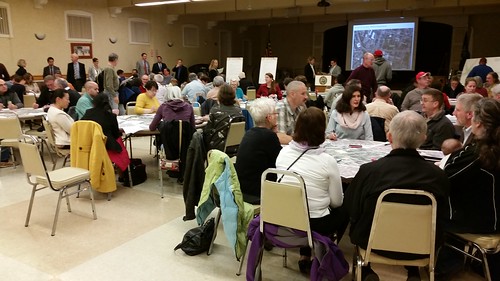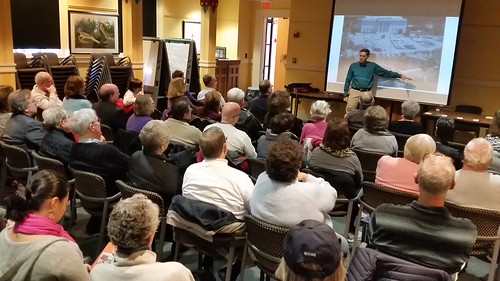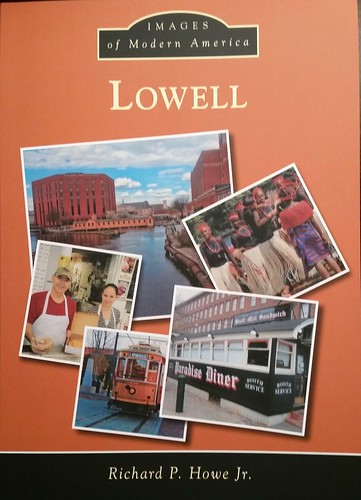Lowell Week in Review: November 22, 2015

It was a busy week in Lowell, perhaps because not much gets scheduled during the upcoming week, the week of Thanksgiving (although if you’re like me, you have a hard time believing that Thanksgiving is just four days away).

Lord Overpass Meeting
More than 100 people attended the Monday night meeting at the Senior Center on the future of the Lord Overpass (see my post-meeting report here). The city’s Division of Planning and Development organized the event. There was a survey about individual usage and ideas about the Overpass that everyone was asked to complete (hopefully DPD will share the survey results soon). Each person attending was given an overhead, color photograph of the vicinity and each table was equipped with a poster-sized version of that photo.
After some preliminary remarks from local officials, the public participation portion of the meeting began. Rather than forming a line before a single microphone with all others in attendance transformed into a passive audience, DPD positioned attendees in small groups around a dozen tables and supplied a DPD-employee to each group to facilitate the discussion. By this method, each individual had a greater opportunity to share observations and ideas. Hopefully the other facilitators were taking notes as comprehensively as the staffer at my table was doing. If they were, DPD will have a substantial amount of citizen input.
And what was that input? On the macro level, there were pleas to tear the entire Overpass down. I think everyone in attendance, including those who suggested that, knew it was unlikely if not impossible, but explicitly saying tear it down emphasized the displeasure with the Overpass as it is now.
On a more micro level, three suggestions seemed widely favored: (1) make Appleton/Chelmsford Streets and Middlesex Street both two-way as they cross the Overpass. That way, someone driving in-bound on Middlesex or outbound on Appleton could just go straight and not have to navigate portions of the circular Overpass; (2) provide buffer zones of mulch and shrubs between sidewalks and adjacent streets as a way of separating walkers from cars; and (3) gain the space needed for these buffer zones by decreasing the width of all lanes on Thorndike and Dutton. There was grudging acknowledgement that these roads would have to remain two-lane in each direction; by narrowing those lanes, the traffic will be calmer and pedestrians will be safer.
One area that creates continuing concern is the proposed four-way intersection of Fletcher, Dutton, Jackson, and Thorndike. Everyone thinks it’s a good idea to connect those roads, but no one (at least no one who isn’t a traffic engineer or an employee of the city) thinks the proposed layout will work well for vehicles or be safe for pedestrians.
The meeting closed with Craig Thomas, the point person for DPD, saying that the DPD staff and the engineering consultants hired to design this renovation project will digest the public suggestions and will bring them back to us at another public meeting in January or February to unveil the final design.
I have some concerns.
As nice as it was to have a public meeting and to solicit input from the public, there is no guarantee that any of that input will find its way into the final plan. The designers of this project were not selected for their expertise in walkability; they were selected because they are good at designing roads and bridges. That’s what they’ve been trained to do and that’s what they do.
Rather than put the burden for walkability design on untrained members of the public, why can’t the professionals take our clear desire for better walkability and then show us some options? Other cities, other places, have converted 1960s era, hazardous-to-pedestrian roadways into spaces that are safe and convenient for people using every method of transportation, not just cars and trucks. Why can’t we see some examples? It would be nice to have another meeting or series of meeting at which design concepts are shared with the public, rather than just one grand unveiling of the final plan.
City Council Meeting
Despite not a single council motion on the agenda, last week’s council meeting covered some important items. The report on the possibility of a replacement for the Rourke Bridge from Beverly Woods of the Northern Middlesex Council of Governments was interesting. So was a comment left by Brian, one of our regular contributors, especially on items dealing with walkability and the place of cars in the city. Here is some of what Brian wrote in his comment to my council meeting report:
To my friends in the Highlands: You should be organizing a rally outside the Northern Middlesex Council of Governments to SAY NO to a new 4 lane Rourke Bridge. When you increase capacity of roads you increase congestion. . . More people from Dracut, Tyngsboro, NH etc. will use the bridge as a cut through to RT 3 and 495. Developers will build more cheap tract housing and strip malls in Pawtucketville. You can’t widen Wood St, Drum Hill, or Stevens St so how will the additional cars not increase congestion on those streets?
My own recent experience corroborated much of what Brian asserted. Just that morning, Tuesday, I had jury duty in the Somerville District Court with a report time of 8:15 a.m. Almost any time I go into Boston, I ride the train and then the MBTA, but the directions to the Somerville Court listed a couple of bus lines as the public transportation option so I opted to drive. Leaving Lowell at 6:30 a.m., I soon joined three lanes of bumper-to-bumper traffic heading south on Route 3. As I rolled along at 10 mph, I remembered how a dozen years ago, regional politicians, business leaders, and the mainstream media all proclaimed that “widening Route 3” would bring an economic renaissance to Greater Lowell. I don’t know if that happened; probably not. I do know that after all the work and expense of widening the road, the main difference I see is that I get stuck in rush hour traffic with three cars abreast, rather than the former two cars abreast. So yes, Brian’s comment resonated with me. (As for my jury service, despite sitting in the jury room for the entire morning, none of the cases actually went to trial so we were all dismissed in time for lunch). Building more lanes just means more people will fill up the space, leaving the same traffic problems and a big price tag. To solve traffic problems, better options not more lanes is the answer.
School Committee Meeting
I didn’t watch it but Amy Bisson did and she wrote a full report about it along with some analysis sharpened by her years as a Lowell Public School teacher (she retired last year). With so many members of the school committee leaving the board next month, there is a scramble to finish priority projects so please read Amy’s report.
LTC turns 20
Congratulations to Lowell Telecommunications Corporation which celebrated its twentieth birthday at its annual meeting held this past Thursday night. I was assigned the task of giving a brief history of LTC. In the process of researching the topic, I discovered and was reminded of many interesting things and will do a separate blog post in the near future about the history of LTC.
As a preview, he’s a list of the initial board of directors of LTC from back in 1995: President-George Duncan; Treasurer-Phil Nyman; Clerk-Robert Redding; Directors-Celementine Alexis, Steven Arnoff, Gail Bartlett, Susan Black, Stanley Brand, James Canavan, Ike Cohen, Jack Costello, Carole Cowan, Arthur Cryan, Maria Cunha, Mike Demaras, Robert Donovan, Cecilio Hernandez, Fr. Herve Gagnon, Jay Joshi, Perry Kapiloff, Ray LeBlanc, Joan Matthews, Margaret McDevitt, Noreen Mellen, Bill Merrill, Rosemary Noon, Martha Norkunas, Anne O’Brien, Michael O’Brien, Dan O’Connor, Maliss Phay, Richard Rambur, Susan Rourke, Lura Smith, and George Zaharoolis.

Book launch talk at Pollard Memorial Library
Lowell: Images of Modern America
Thanks to the 80+ people who attended my book launch event at the Pollard Memorial Library. The new book, Lowell: Images of Modern America, is a photographic history of Lowell from 1950 to the present. The book is available online from Amazon and at Barnes and Noble stores in Burlington, Nashua, and Salem, NH.

On Saturday, December 12, 2015 at 2 p.m. at the Pollard Memorial Library, the Lowell Historical Society will host a program called “Lowell History Since World War II.” Paul Marion and I will be the speakers and we will both have copies of our respective books (Paul’s is Mill Power, a history of Lowell National Historical Park) available for sale and signing.
Happy Thanksgiving to everyone.
To allow development from Drum Hill to the Rourke bridge was thoughtless. Not to replace a “temporary” bridge for 32 years is unacceptable. Bridges and roads are for all to use. I live near the bridge, I know when the rush hours are. I also know walkers and bikers cannot safely pass each other in the narrow cage on one side of the bridge. The bridge gets a lot of ambulances going to LGH but how do you pull over when there’s no room? We also have a lot of regattas, festivals and events along the river. Has UML, LGH, D’Youville Manor grown? The current bridge cannot handle the number of people that need to cross the river and there’s talk of a DeMoulas supermarket on Old Ferry Road. Brian, strip malls and tract housing? If we have more lanes on a new bridge perhaps traffic will flow more smoothly, we wouldn’t have blocked intersections and road rage when 3 lanes converge into one.
Regarding the Lord Overpass public meeting and in response to “next steps” – the VHB engineer at our table mentioned that they would return (pre-January??) with three scenarios for us to look at. That is certainly a better idea than coming back and unveiling a final scheme. Perhaps we need to ask them to follow up on that idea as opposed to sitting on our hands and waiting for the January “unveiling”.
Linda, I agree that it would be easier for ambulances to cross the river, if we get a wider Rourke Bridge, but the effects of a wider bridge will only last for a finite time. If you build a road, they will drive it. I believe that what Brian and perhaps Dick are getting at is that we need to plan for alternates (not just alternate bridges). We should make it possible for people to work closer to jobs so that they can bus, walk, bike or run to work, We should be encouraging parents to let their children ride the bus, walk or bike to school. As a pedestrian, I don’t mind so much avoiding cars when they are stopped as much as cars going 40 to make a light. Cars are not going 40 to make that light at rush hour or school time.
I used to be fully in favor of a new bridge, but now I am not so sure. I would support it more if the new bridge were part of a more comprehensive solution to auto traffic in the area. My gut tells me that if there is a new bridge, that land in Pawtucketville, Dracut and New Hampshire will become that much more appealing to build on. With Lowell being the most convenient river crossing point, this will add more through traffic. I see this problem as similar to situations in which neighbors seek to close a street down at one end to make a dead end. This may serve to calm traffic on that one street, but at forces more cars onto fewer options. This is what makes New York City much easier to navigate, because there are so many options. If they NYC did not have such a robust, complex an complex traffic system commute times would be much longer. The worst commutes there are were the options are the fewest. This is not just true for auto traffic, but all forms of traffic. The more options or choices a commuter has, be it paths, roads, bus routes, sidewalks, bike paths,…. the better a selection he or she can make about getting from point A to B. This also applies to modes of transit as well.
I have a serious concern with one Rourke Bridge option, the choice to make a limited access type exit by J.J. Boomers. I find that there are two primary flaws with this option: 1) it focus the traffic into one option toward Old Ferry Road and then onto Varnum Ave. 2) It looks ugly and behemoth in size and would present more barriers to pedestrian and bicycle permeability. As for the first point, I understand that the concern and goal for many people is to eliminate or reduce cut through traffic. This is nice for the people that live on the streets where traffic is reduced, but the people who live on the arterial roads will bear the brunt of the new traffic (I live on such a road, but on the other side of the rive). By trying to force drivers or commuters into fewer options, traffic jams or grid lock will surely follow.
Great RT 3 analogy Dick.
Linda,
Traffic will not run more smoothly. More cars means more congestion ergo more road rage. Do you understand the concept of induced demand? Please read this https://northbaydesignkit.blogspot.com/2015/11/induced-traffic-congestion-and-peak.html?m=1
Let it digest. Then read it again.
People moved to west Pawtucketville because it’s quiet and housing is cheap. But its drivable suburban development pattern and remoteness means you need a car for all of your daily needs. Hence the cheap housing. But as UML etc has grown that 15 min trip across the bridge has turned into a 45+ minute trip.
Many people now choose to not make the trip during peak times to avoid sitting in traffic. If a new bridge is built with more lanes those same people will instead decide to take the trip during peak times. These latent trips are just waiting to happen.
Commuters who currently use other routes to get across the river will adjust and use a bigger Rourke bridge. If Demoulas is allowed to build a strip mall in Pawtucketville it will induce the typical chain store, low wage crap we see in Drum Hill. With a grocery store easily accessible on that side of the river suburban housing developers will go on a building spree. This will all lead to more cars and we’re right back where we started. Congestion.
The city should tamp down low returning suburban and “near the highway” development. It should encourage high returning mixed-use growth in the walkable urban neighborhoods. It’s the ONLY way to beat congestion.
Brian, Pawtucketville is already undergoing more development WITH the city’s blessing and the cheap housing you refer to is my home. My neighbors may welcome a grocery store on our side. People in Pawtucketville may need nearby employment. I don’t presume to speak for them. We can’t all ride bikes or walk even in good weather. Should we move, give up our cars or charge a fee for those who use the Rourke bridge but don’t live in Lowell? I know a new bridge is not a silver bullet to congestion but everything around us is drawing more cars. If you have a study specific to the Rourke bridge I’ve probably already read it.
Paul, the DOT presented plans for a new bridge because they were trying to remedy a problem they ignored for 32 years. The DOT presented options, residents spoke but what is chosen was not our call. My street already enjoys extra traffic because other side streets have instituted limited use. Residents don’t control land development, state, city or town officials do.